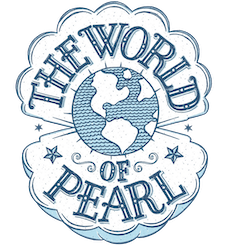Anna emailed us wanting to know about the black spots on pearls. She was unsure of the origin of her pearls, if they might be river pearls and why certain pearls have black spots.
Now, I love chatting about pearls and I know a lot but I never claim to know everything so, as always, feel free to take my assessment or leave it. It is especially tough to make an assessment of pearls based on an image… it is always easier in person! But, here are my thoughts on Anna’s pearls and here is why there are black spots on pearls!

Dear Anna,
Thanks so much for your email! You are right, it is so much easier to look at pearls in person so I can only give you my ideas based on these images… so feel free to take my words with a grain of salt. I would, given my limited exposure to your pearls. My initial reaction is that these are cultured pearls mixed with keshi pearls (the misshapen pearls). Keshi pearls happen when a mollusk rejects a nucleus but still forms a pearl within the pearl sac. So, these are non-nucleated pearls. Not exactly “natural” pearls because they have had human intervention to start the pearl making process but not exactly the same as cultured pearls either since they do not have a nucleus and are all nacre. When I work with my pearl divers and their natural pearls, some of the pearls have what they call dead spots. this might be a dark spot or hole where either there is a black spot and a lack of nacre. These black spots appear to be some sort of “dead” spot. They are a sign of no nacre, poor nacre development, some sort of occlusion or a place where the pearl did not develop well.
My guess are these are not river pearls unless these are a mix of river and cultured pearls. For one, you will not see keshi pearls in river pearls since they are a byproduct of cultured pearls and pearls are typically not cultured in the rivers. Also, this is quite a full strand of pearls and to find this many round river pearls would have taken lots of time and a vast amount of pearls to match them on the strand. From your picture the pearls do look well matched.
To get down to the nitty gritty with your pearls including origin, nacre and nucleus type, you can mail your pearls to the GIA for assessment. The true lab testing is your best way to be 100% sure of what you have. Pearls can sometimes deceive even the keenest eye in jewelry so to be absolutely sure, I would get them tested.
Best of luck to you! These are very lovely pearls and I am sure you enjoy them immensely!
Warm Regards,
India
I am a modern day treasure hunter who travels the world for gorgeous pearls and amazing adventures. I own a pearl jewelry and jewelry repair business, ThePearlGirls.com, with a cute retail store in Athens, GA. I also have a Pearl Travel business and travel blog at TheWorldofPearl.com.



